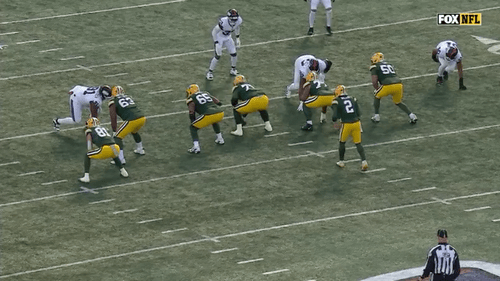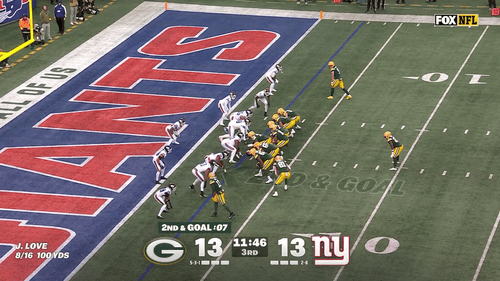What questions did the Packers answer and which ones remain open entering Week 12?
The Packers got back in the win column and made meaningful progress in some areas. However, Sunday's tilt with the Giants didn't quite represent a get-right game.
Good morning!
On Sunday, the Green Bay Packers snapped their losing streak, dispensing with the New York Giants at MetLife Stadium. While the tilt put Green Bay back in the win column and the team made meaningful progress in some areas, it didn’t quite represent a get-right game.
Today’s edition of The Leap looks at some of the questions that the Packers addressed during Sunday’s victory as well as others that remain unanswered entering Week 12.
Thank you for reading and supporting our coverage. You can also support our work by following us on social media:
Jason B. Hirschhorn: @by_JBH on Twitter / @byjbh@bsky.social on Bluesky / @by_jbh on Threads
Peter Bukowski: @Peter_Bukowski on Twitter / @peterbukowski@bsky.social on Bluesky / @peter_bukowski on Threads
The Leap: @TheLeapGB on Twitter / @theleap.bsky.social on Bluesky / The Leap's YouTube channel
If you appreciate thoughtful, independent coverage of the Packers and NFL, please consider becoming a paid subscriber. Your support allows us to serve this community with the stories and reporting it deserves.
As always, thanks for making The Leap a part of your day.
Answered: Can Matt LaFleur break out of his play-calling rut?
Jason B. Hirschhorn: When it comes to assessing play-calling, looking at the big picture and situational trends will usually provide a better indication of quality than a single decision here or there. That doesn’t mean play-callers can’t make egregious mistakes on one down that stand out, but that only tells part of the story.
A week ago, Packers head coach and offensive play-caller Matt LaFleur delivered one of his worst games in those roles. The Leap highlighted the gory details on Tuesday:
The Green Bay offense bordered on a caricature of itself on Monday. LaFleur leaned so heavily on the run that Jacobs hit double-digit touches less than 20 minutes into the contest. The Packers didn’t attempt a pass on first down until midway through the second quarter. Meanwhile, their designed runs on first down averaged a dismal 2.8 yards, a clip that looks even worse when considering how often the Eagles played defense with a light box.
In that matchup, LaFleur’s game plan didn’t work due to the Packers’ inability to run against the Philadelphia Eagles, mainly due to the offensive line’s inability to open rushing lanes. However, once it became clear that the ground game couldn’t take advantage of the advantageous looks, LaFleur could have pivoted to another approach. Instead, he stayed the course, and the same results followed.
Fortunately for Green Bay, LaFleur entered Week 11 with a better plan and a willingness to adjust on the fly. Minutes into the Packers’ first possession, they ran a pass on first down, a stark difference from a week ago. LaFleur also dialed up more keepers in the first half of Sunday’s game than he did during the entirety of Week 10, along with more specials that forced the Giants defense to defend horizontally as well as vertically.
LaFleur also successfully shifted gears when Jordan Love left the game to deal with a shoulder injury. On just the second play with Malik Willis under center, the Packers ran a designed QB run dressed up with pre-snap eye candy to fool the defense and give him blockers on the move.
The Packers also did a much better job in the red zone than they had in recent outings. All three of their trips inside the opponent’s 20-yard line resulted in touchdowns. Christian Watson made two impressive grabs in the end zone, but LaFleur’s play design deserves most of the credit for Josh Whyle’s go-ahead score.
That said, no one could reasonably call Sunday a banner day for the Packers offense. Execution errors undermined multiple early drives, most notably the dropped passes. Pro Football Focus charted Green Bay with three drops in total, but other sources could reasonably adjust that figure higher. Regardless, those mistakes kept the team from capitalizing for much of the game.
“I thought there were plenty of opportunities in the game to build a little bit of a lead,” LaFleur said of the drops. “We didn’t make plays. We didn’t make those plays, unfortunately.”
While coaches do share in the blame for consistent mistakes like drops, that doesn’t reflect the quality of the play-calling. Romeo Doubs might have dropped multiple balls while open, but the play call still got him open in the first place.
The Packers won’t reach their potential without improved execution. However, LaFleur at least took steps in the right direction with the play sheet.
Unanswered: Do the Packers have a healthy starting tight end on the roster?
JBH: Following Tucker Kraft’s season-ending knee injury, the Packers turned to former second-round pick Luke Musgrave as the new lead tight end. He played 52 offensive snaps a week ago, almost 77% of the unit’s total. And while Musgrave didn’t have a ton of statistical production -- 3 catches for 23 yards -- his place in the offense appeared clear.
Just six days later, Musgrave might have pushed his way out of the rotation.
Among the three tight ends on the 53-man roster, Musgrave had the fewest snaps Sunday, according to Pro Football Focus. Worse, the vast majority of that work came in the first half. After halftime -- and following one official fumble out of bounds and another overturned via replay -- the Packers barely used Musgrave, preferring to give more opportunities to John FitzPatrick (35 offensive snaps in total) and the aforementioned Whyle (20).
When a recent second-round pick falls behind two mostly unproven players acquired off the street, it indicates the coaching staff’s lack of faith in that former selection.
And Green Bay doesn’t have another lever to pull at the position. Kraft won’t return until sometime next season, and the trade deadline passed nearly two full weeks ago. Unless tight-ends coach John Dunn can find a way to help Musgrave finally break through, the Packers will need to reconsider how much 12 personnel they use moving forward.
Answered: Why did the Packers continue to roll with an injured Brandon McManus?
JBH: For several weeks, innumerable Packers fans and my co-founder here at The Leap have wondered aloud why the Packers continued to roll with Brandon McManus at kicker despite a quad injury.
The raw numbers for McManus don’t inspire much confidence. Entering Week 11, he converted just 64.7% of his field-goal attempts, nearly 20 percentage points below the league average. And though he has made 100% of his field goals inside 40 yards, he knocked through just 1 of 5 from 40-49 yards, well within the expected range for a professional kicker.
After journeyman Lucas Havrisik converted all his kicks -- extra points included -- during McManus’ two-game absence, it seemed as though the Packers had a viable alternative already on the roster.
Then came Sunday.
While the wind made for some difficult kicks, Havrisik endured a dreadful unofficial audition for the full-time job. He missed two extra points, and though one of those attempts came off a bad hold by punter Daniel Whelan, the relatively short distance to the uprights makes those misfires particularly difficult for the Packers to ignore.
And it doesn’t sound like the coaches will excuse the misses due to the weather conditions.
“The bottom line is -- and we experience this quite often in our practice facility, where it is windy -- ultimately, you got to find a way,” LaFleur said of the missed kicks, adding that the team did not instruct Havrisik to kick the ball through the end zone on the Giants’ penultimate possession.
Just as importantly, LaFleur didn’t make it sound like McManus would miss much more time, describing the kicker’s quad injury as “day to day.”
None of which means the Packers made the correct call in sticking with McManus. Perhaps, given what has transpired over the course of the year, the team simply doesn’t have a reliable kicker. Again.
Unanswered: Why didn’t Malik Heath travel with the team to New York?
JBH: While McManus’ status change drew most of the attention Saturday, the Packers also announced that wide receiver Malik Heath would not travel with the team due to a “coach’s decision.” That development would have mattered under nearly any circumstances. However, with the Packers’ receiving corps banged up after the past few games, Heath’s absence seemed even stranger.
“I’m just going to keep that between our team,” LaFleur said when asked about Heath not playing against the Giants. “It’s just one of those decisions. I will say this about Malik. I think he’s definitely a valued member of our team. He’s put in a lot of good work for us. And I look forward to seeing him tomorrow.”
LaFleur’s tone and phrasing will sound familiar to those who remember his comments after the Packers suspended Romeo Doubs for one game last season. While that could mean that Heath simply re-enters the fold, he doesn’t hold the same stature on the roster as Doubs does. Especially with injured players expected to come off injured reserve in the coming weeks -- Jayden Reed chief among them -- Heath’s return might look a little different than it did for Doubs.
Answered: The current version of O-line will limit upside
JBH: Since the regular season began, the Packers have done little tinkering with their offensive line. Outside of rotating Sean Rhyan and Jordan Morgan at right guard for a stretch, the only changes along the unit have come via injury.
While the Packers have a workable O-line, it hasn’t played up to expectations for most of the season. That underperformance continued Sunday, with the unit yielding 10 pressures, according to PFF’s charting. Morgan and Rasheed Walker fared the worst of the group, giving up three pressures apiece.
For one reason or another, Morgan hasn’t settled in at right guard. Despite checking the boxes for the position, he continues to struggle in pass protection. Morgan actually yielded even more pressures a week earlier, allowing four against the Eagles. This marks the second time in 2025 that the former first-round pick has accounted for seven pressures over a two-week span.
The Packers don’t have enough healthy, proven offensive linemen to bench Morgan, but they could reconsider how to use him. Perhaps he should transition back to tackle where he played in college. Maybe he just needs to shift back to the left side of the line. But whatever the case, the coaching staff has to at least consider whether he could give the team more in a different role.
Regardless of what the Packers ultimately decide, the offensive line has to play better than it has for the offense to reach its potential.




